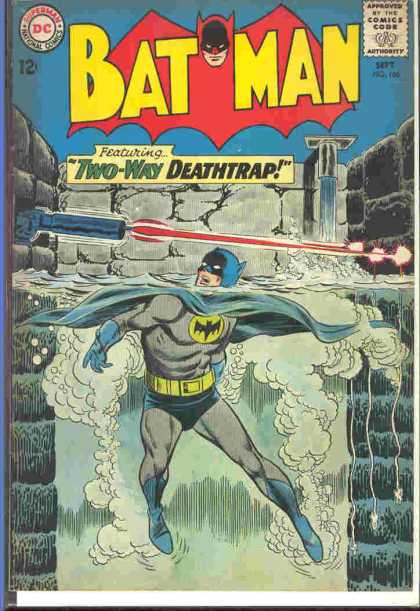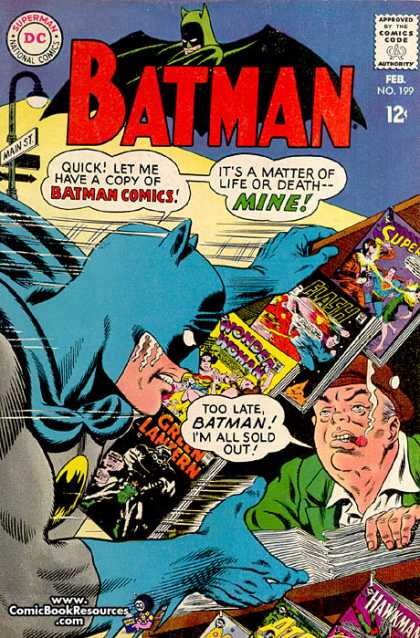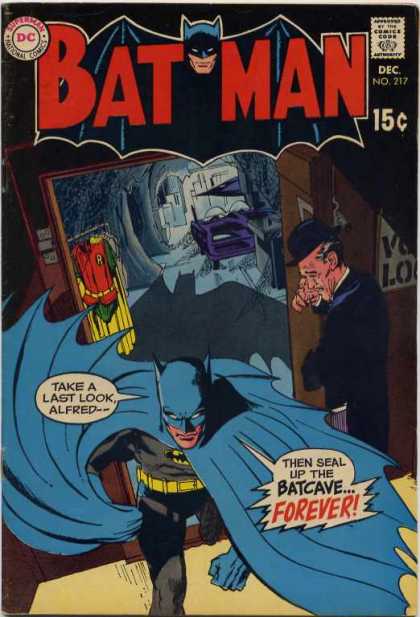What Really Rescued the Caped Crusader
 Yesterday I argued that, contrary to what Bob Kane believed and a lot of comic-book historians have written, DC Comics wasn't really planning to cancel Batman in 1963 and 1964. By all other indications, the character was still one of the company's most popular, and the magazines featuring him still among its top sellers.
Yesterday I argued that, contrary to what Bob Kane believed and a lot of comic-book historians have written, DC Comics wasn't really planning to cancel Batman in 1963 and 1964. By all other indications, the character was still one of the company's most popular, and the magazines featuring him still among its top sellers.
So why did DC's top brass tell Kane that they were thinking of canceling Batman entirely? I think the answer lies in his unusually expensive 1947 contract. The problem with Batman comics probably lay not in their income but in their costs.
The publisher wanted Kane to give up his high per-page rate and his stultifying creative control. I suspect its head, Irwin Donenfeld, used brinkmanship to open new negotiations, and that tactic worked. DC was able to move the Batman comics in a new direction.
It's notable that the June 1964 issue of Detective, touting the "New Look," also included a two-page autobiographical article from Kane. Was the company mollifying his considerable ego after it had squeezed out contract concessions?
Naturally, the editor and artist involved in creating the "New Look"--Julius Schwartz and Carmine Infantino--were pleased to think that they had helped to save a classic character. They certainly brought in new creative energy. And once fans got used to the new style, the rescue of Batman became a heroic narrative. But the character had remained relatively popular, and the sales numbers hadn't been that bad to begin with. Nor did the sales rise that much afterwards. When DC began reporting figures for its hero comics in 1965, after a two-year gap, Batman was once again ranked ninth among all magazines on the list, selling 454,000 copies. Sales had grown slightly over the 1962 figures, but were still behind the numbers from 1961. Superman comics were still solidly in the lead, but Batman books were more popular than those of any other DC character.
Nor did the sales rise that much afterwards. When DC began reporting figures for its hero comics in 1965, after a two-year gap, Batman was once again ranked ninth among all magazines on the list, selling 454,000 copies. Sales had grown slightly over the 1962 figures, but were still behind the numbers from 1961. Superman comics were still solidly in the lead, but Batman books were more popular than those of any other DC character.
There was a huge change in 1966, with the debut of the Batman TV show. Suddenly Batman was the top comic book of all, selling almost 900,000 copies. In late 1964, Batman began to appear more often on the Justice League of America comics; after 1966, he often dwarfed other figures on those covers. The "New Look" of 1964 reversed a sales decline, but television put Batman on top.
And then television took it all away. By 1969, Batman was yesterday's fashion, which is even worse than being old-fashioned. Sales were down to 356,000 per month. (To be fair, DC was issuing ten issues a year instead of eight, as in 1964.) And at that point, the law governing periodicals changed, and DC Comics stopped reporting average sales. I therefore have no way of knowing how Batman's second revamping in the 1960s affected the comic books' sales. In reaction against the TV show's camp, artist Neal Adams, writer Dennis O'Neil, and their colleagues created a more serious Batman in 1969. Dick Grayson went off to college, as shown here, and Bruce Wayne moved into an apartment in Gotham. Those stories were supposed to be more about solving crimes than chasing goofy criminals--though there was an awful lot of supernatural stuff in the next few years.
I therefore have no way of knowing how Batman's second revamping in the 1960s affected the comic books' sales. In reaction against the TV show's camp, artist Neal Adams, writer Dennis O'Neil, and their colleagues created a more serious Batman in 1969. Dick Grayson went off to college, as shown here, and Bruce Wayne moved into an apartment in Gotham. Those stories were supposed to be more about solving crimes than chasing goofy criminals--though there was an awful lot of supernatural stuff in the next few years.
We like to believe that new inspiration on the creative side--the "New Look" designed by Infantino, the newer look designed by Adams--leads to increased popularity. I'm not sure it always does. Certainly its effect can't come close to that of a prime-time TV show.
(All images courtesy of Cover Browser.)


2 comments:
Excellent series of posts. I suspect that the real date that DC considered cancelling Batman was around 1968-70 or so, after the TV show went off the air. This fits in better with Kane's buyout (which came in 1968).
Some additional information I didn't have when I wrote about this at Silver Age Comics and elsewhere:
1. Circulation of almost all comics dropped sharply in 1962 as compared to the prior year. This was due t the price increase to 12 cents, which took effect in late 1961. Superman was off 10% in sales in 1962, so Batman's sales decline is worse, but not extraordinary.
2. If we look at 1962-65, Batman's sales increased by 11%. An improvement, to be sure, but Superman's sales were also up 11%. Jimmy Olsen was up 18%, Adventure up 25%, Action up 21%, JLA up 14%. Indeed, the only titles of DC that suffered circulation declines in that period were Blackhawk, Mystery in Space, Wonder Woman, and Sea Devils.
3. There are circulation statistics from DC going well into the 1970s. Batman suffered strong and steady declines from 1966 onwards:
1966 898,000
1967 806,000
1968 533,000
1969 356,000
1970 294,000
1971 244,000
1972 185,000
Thanks for the added data, and the possibility that Kane was way off in his memory of when DC told him it might cancel Batman.
I still suspect the Batman character was too valuable for DC to have gone through with that possibility, but the company could have cut back on the magazines featuring him, either in number or frequency.
The drop in sales from 1966 to 1972 is striking. Batman fans view the series and the character as being creatively rejuvenated in that period, with Neal Adams’s visual interpretation leading the way. Yet that artistic growth doesn’t appear to have paid off for DC in sales growth. Of course, if the whole line or whole industry declined, the Batman magazines could still have been among the company's best sellers.
Post a Comment